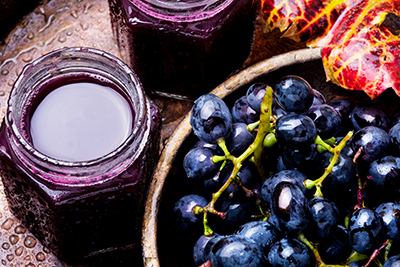Contents
Apart from the many health benefits of grapes, they are like the orange, the most cultivated fruit in the world. Unfortunately, only a tiny percentage of the crop is eaten as fruit; most is destined for producing alcoholic beverages, particularly wine.
Grapes are essential to the Mediterranean diet and even the regional culture. For a good reason, they have been cultivated in the warm lands surrounding the sea for thousands of years. Recent scientific discoveries attributed the good cardiac health of Mediterranean people, specifically to some of the substances found in grapes.

Grape Nutritional Facts
Two types of nutrients stand out in the grape’s composition: sugars and B complex vitamins. On the other hand, grapes supply few proteins and fats. Grape proteins, although scarce, contain all essential amino acids. Minerals are present in moderate amounts. These are the grape’s components that merit discussion:
Sugars are present in proportions that vary between fifteen percent and thirty percent. Grapes grown in cold regions tend to have lower sugar content, while those from hot, dry climates are much sweeter. The muscatel grape is the loveliest of the 3000 varieties produced worldwide.
The two most abundant sugars in grapes are GLUCOSE and FRUCTOSE. From a chemical standpoint, these are MONOSACCHARIDES or simple sugars capable of passing directly to the bloodstream without needing digestion. This contrasts with other types of sugar, such as saccharose (found in sugarcane, sugar beets, or bananas) or lactose found in milk, which must be digested in the intestine before they can pass into the blood.
Vitamins—With 0.11 mg/100 grams of vitamin B6, grapes are among the wealthiest fruits in this vitamin, surpassed only by tropical fruits such as avocados, bananas, cherimoyas, guavas, and mangoes. Vitamin B1, B2, and B3 or niacin are also present in amounts more significant than most fresh fruits.

All of these vitamins are responsible, among other things, for metabolizing sugars, thus facilitating their chemical “combustion” within the cells to provide energy. Here, nature gives yet another example of intelligent design by providing plenty of sugars within the grape with the vitamins needed to convert them to energy.
Grapes also contain significant amounts of provitamin A (7 ug RE/100 g), vitamin C (10.8 mg/100 grams), and vitamin E (0.7 mg/100 grams).
Minerals—Grapes contain the most minerals, potassium, and iron but also calcium, phosphorus, and copper.
Fiber – Grapes contain around one percent soluble vegetable fiber (pectin), a significant amount for fresh fruit.
Non-nutritive substances – Grapes contain numerous chemical substances that do not fit into any of the classical groups of nutrients but exercise many functions within the body, many of which are still not understood. These substances are also known as PHYTOCHEMICALS:
- Organic acids give grapes a slight tart flavor. They have a paradoxical effect on the blood, producing alkalization (a process known in chemistry as an amphoteric effect). Alkalization of the blood and urine facilitates the elimination of metabolic wastes, mostly acidic, such as uric acid.
- Flavonoids: Grapes contain flavonoids, which are phenols. Recent studies have shown that they act as powerful antioxidants, preventing the oxidation of cholesterol that causes arteriosclerosis and preventing the formation of blood clots in the arteries. Quercetin is the most critical flavonoid in grapes.
- Resveratrol: This is a phenolic substance in grape skins that acts as a fungicide and is an antioxidant. It impedes the progress of arteriosclerosis and has recently been shown to be a powerful anticarcinogen.
- Anthocyanidins are vegetable pigments found in the skins of white, mainly black grapes. They are potent antioxidants that can prevent coronary heart disease.
Health Benefits of Grapes
In essence, it may be said that grapes provide energy to the cells and promote the health of the arteries, particularly those that nourish the heart. They are also laxative, antioxidant, diuretic, anti-anemic, and anti-tumor. These are their primary medical indications:
Cardiovascular disease in general – Grapes are highly recommended for any cardiac conditions because:
Health benefits of grapes: They provide energy through simple sugars that the heart muscle uses to contract. Although the heart’s primary energy sources are fatty acids, it utilizes glucose.
Health benefits of grapes: They are rich in potassium and contain calcium and magnesium, which are involved in cardiac contractions.
Health benefits of grapes: Additionally, grapes contain virtually no sodium or saturated fat, the two primary enemies of the cardiovascular system.
Coronary artery disease—The arteries that feed the heart muscle suffer stenosis (narrowing) relatively frequently due to spasms and cholesterol deposits on their walls. These coronary artery disorders are manifested through angina or, when the blockage of blood flow is permanent, myocardial infarction (heart attack).
The phenolic non-nutritive substances present in grapes (flavonoids and resveratrol) produce the following beneficial effects on circulation through the arteries in general and coronary arteries in particular:
- Vasodilation, thus overcoming arterial spasms and increasing blood flow.
- Reducing the tendency of blood platelets to form clots reduces the risk of arterial occlusion caused by arteriosclerosis. Ethyl alcohol also produces this effect, but only at high blood-alcohol levels (2 grams per liter) incompatible with good health.
- Inhibition of the oxidation of the cholesterol transported by low-density lipoproteins (LDL). The oxidation of this type of cholesterol (harmful) initiates the process of creating deposits on the artery walls, giving rise to arteriosclerosis.
In summary, investigations of grapes and grape juice demonstrate that both can dilate the arteries, improve blood flow without forming clots, and impede cholesterol deposits on arterial walls. What else might be expected of food that protects the heart and circulatory system?

RED WINE (not white) also exercises the same actions since it retains some active substances in grapes. However, it has drawbacks compared to grapes or grape juice. Wine has few sugars or vitamins, and it contains a toxin, ethyl alcohol, that the body must eliminate from the blood by “burning” it in the liver.
Because of this, grapes or grape juice are far better than wine as protectors of the cardiovascular system and have no undesirable effects. The cardiac patient who eats grapes regularly during the summer and autumn and raisins or grape juice the rest of the year will note how the heart improves in its response to small efforts. Those recovering from heart attacks should include grapes in their diet to stop the progress of coronary arteriosclerosis.
Arteriosclerosis – Regular consumption of grapes or grape juice is indicated for arteriosclerosis regardless of where it is located within the body and the coronary arteries. Iliac-femoral arteriosclerosis, which produces a loss of blood circulation in the lower extremities, and carotid arteriosclerosis, which affects the brain, are the most common. In both cases, grape consumption can stop the hardening and narrowing of these arteries and improve blood flow. A three-day grape treatment, applied every two weeks, is very effective in severe cases.
Thrombosis—Grapes, grape juice, or raisins can reduce the blood’s tendency to form clots within arteries and veins. This is especially significant for those who have experienced a stroke or are at risk.

Anemia – Grapes are one of the richest fresh fruits in iron (0.26 mg/100 grams). Because they are more concentrated, Raisins are much richer in iron (2.59 mg/100 grams) and higher than lamb (2-2.5 mg/100 grams). The iron in grapes is nonheme, and it is more difficult to absorb than the iron in meat. However, its absorption is greatly enhanced when facilitated by the presence of vitamin C found in the grape itself or other plant-based foods.
Grapes are also exceptionally rich in copper, a trace element that facilitates the absorption and assimilation of iron. All who tend toward anemia will notice improvement with the regular consumption of grapes during the summer and autumn months and with raisins during the rest of the year.
Liver disorders—Grapes activate the liver’s detoxifying effect, increasing bile production (choleretic action). Furthermore, grapes accelerate blood circulation in the portal system and thus are of value in cases of cirrhosis and ascites (accumulation of fluid in the peritoneal cavity) due to portal hypertension.
Hemorrhoids – Many hemorrhoid cases are fostered by venous congestion in the portal system. As a result, they tend to improve with regular grape consumption. In addition, sitz baths in extra grape leaves provide excellent results.
Intestinal disorders—Grapes are a mild laxative that relieves chronic constipation caused by a lazy intestine. They also balance intestinal flora and avoid putrefaction caused by a diet rich in animal proteins.
Renal disorders—Grapes are highly recommended in cases of renal failure due to nephritis, nephrosis, or other causes because of their diuretic and decongestive action, mineral composition, and low protein levels.
Gout and excess uric acid – Grapes are excellent for eliminating uric acid in the kidneys due to their alkalizing and diuretic effects. Regular grape consumption and grape treatment are particularly beneficial for people with arthritis, the obese, and those with a diet rich in meat products.
Asthenia (fatigue)—The stimulating effect of the natural sugars and vitamins in grapes positively affects exhaustion and nervous tension.
Cancerous processes – The RESVERATROL found in grapes, particularly in the skin, has been shown experimentally to possess anti-tumor properties. Although the use of this substance in cancer cases is still under investigation, abundant grape consumption is advised to complement other treatments for those diagnosed with cancer or at risk of it.
Grape Scientific Facts
- Scientific name – Vitis vinifera L.
- French – Raisin.
- Spanish – Uva.
- German – Weintraube.
- Description—Grapes are the fruit of the climbing vine of the botanical family Vitaceae. They are aggregate fruits that grow in clusters of as few as one hundred.
- Environment – Grapes are cultivated in temperate regions such as Mediterranean countries, although they are also grown in protected valleys in Central Europe. The best vineyards on the American continent are in California, Argentina, and Chile.
How to Make Natural Grape Juice

Place whole grapes in a blender. While it is more time-consuming, the seeds can be removed for better flavor. This method is indicated:
- Take complete advantage of the health benefits of grapes, especially on the skin, the heart, and arteries.
- To take advantage of the anti-carcinogenic effect of the resveratrol found primarily in the grape’s skin.
Use a strainer to eliminate skin and seeds. This gives a delicious, fine-textured juice appropriate for all other indications of grapes.
Unfermented grape juice contains the same cardio-protective substances found in wine but in higher concentrations and without the drawback of ethyl alcohol. Additionally, grapes and grape juice provide energy-producing sugars and vitamins that wine lacks.

Raisins
Raisins are made by drying grapes in bunches on the vine, spread out in the sun, or using hot air. They provide less than 300 kcal/100 grams. They are very rich in iron: 100 grams covers one-fourth of the RDA for this mineral. Raisins are also rich in potassium (825 mg/100 grams) and vegetable fiber (6.8 percent). Their fat content is similar to fresh grapes (0.54 percent). B complex vitamins are found in higher concentrations, but vitamin C is limited, and vitamin A is almost absent. Raisins are used for the same purposes as grapes, although their laxative and expectorant quality stand out.
How to use Grapes
- Fresh – Grapes must be harvested ripe since the ripening process stops once the cluster has been removed from the vine. They may be eaten alone, with crackers, or with toasted bread (which aids digestion). Like all fruit, grapes are not recommended as a dessert after a large meal.
- Grape treatment – This involves eating only from one to three kilos of grapes a day for at least three days.
- Natural grape juice (see above).
- Canned grape juice is usually prepared from juice concentrate. It contains the same sugars, although fewer vitamins. Its cardioprotective substances are still present.
- Sour grape juice – This is the juice extracted from unripe grapes. It is sour-tasting and is used as a substitute for lemon or vinegar.
- Raisins. (see above).
DISCLAIMER: All content on this website is presented solely for educational and informational objectives. Do not rely on the information provided as a replacement for advice, diagnosis, or treatment from a qualified medical expert. If you are pregnant, nursing, or have any preexisting medical concerns, talk to your doctor before using any herbal or natural medicines.
REFERENCES
- George D. Pamplona-Roger, M.D. “Encyclopedia of Foods and Their Healing Power.” George D. Pamplona-Roger, M.D. Encyclopedia of Foods and Their Healing Power. Trans. Annette Melgosa. Vol. 2. Chai Wan: Editorial Safeliz, 2005. 78, 79, 80, 81. Print.
- Healthline: https://www.healthline.com/nutrition/benefits-of-grapes
- Medical News Today: https://www.medicalnewstoday.com/articles/271156
- Cleveland Clinic: https://health.clevelandclinic.org/health-benefits-of-grapes/
